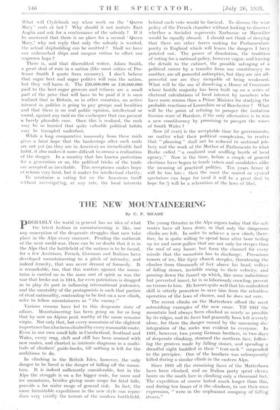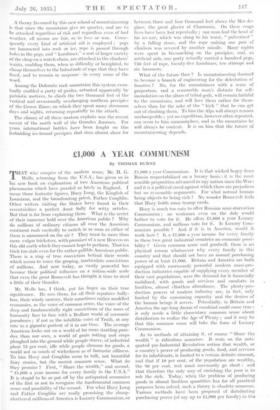THE NEW MOUNTAINEERING
By C. V. MEADE
PROBABLY the world in general has no idea of what the latest fashion in mountaineering is like, nor any conception of the desperate struggles that now take place in the Alps every summer. Pending the outbreak of the next. world-war, there can be no doubt that it is in the Alps that the battlefield of the nations is to be found, for a few Austrians, French, Germans and Italians have developed mountaineering to a pitch of intensity, and indeed ferocity, that was never dreamt of formerly. It is remarkable, too, that this warfare against the moun-. tains is carried on in the same sort of spirit as was the war that broke out in.1914, for even patriotism is dragged in to play. its part in inflaming international jealousies, and the mentality of the protagonists is such that parties of rival. nationality, contending to be first on a new climb, refer to fellow mountaineers as " the enemy."
Various reasons have led to this desperate state of affairs. Mountaineering has been going on for so long that by now no Alpine peak worthy of the name remains. virgin. Not only that, but eVery mountain of the slightest' importance has also been climbed by every reasonable route. Even in our own small hills in Cumberland, Scotland and Wales, every crag, cleft and cliff has been seamed with new routes, and charted in intricate diagrams in a multi-. tude of climbers' guide-books, till nothing is left for the ambitious to do. .
In . climbing in the British Isles, however, the only' danger to be faced is the danger of falling off the moun- tain. It is indeed sufficiently considerable, but in the Alps the struggle is on a far bigger scale, for snow and ice mountains, besides giving more scope for fatal falls, provide a far wider range of general risk. In fact; the more formidable expeditions in the new style can repro-' duce very vividly the terrors of the modern battlefield. The young thruster in the Alps argues today that the safe routes have all been done, so that only the dangerous climbs are left. In order to achieve a new elinib,.therc- fore, he is quite willing to spend hour after hotir up ice and snow gullies that'.are not only far steeper than the roof of any house, but form the channel for every missile that the mountain has to discharge'. Precarious' towers of ice, like tipsy church steeples, threatening the climber. from thousands of feet above his head; volleys of falling stones, invisible owing to their velocity; and pouring down the funnel up which, like some' indristrious but perverted insect, he is so laboriously crawling, present no terrors to him. He knows quite well that his undoubted skill is utterly powerless to save him from the relentless operation of the laws of chance, and he does• not care.
The recent climbs on the 'Matterhorn afford the most astonishing examples of the new craze. Till 1931' the mountain had always been climbed as nearly as possible by its ridges, and its faces had generally been left severely alone, for there the danger caused by the unceasing dis= integration of the rocks was evident to everyone. In 1931, however, two young German brothers, in two days of desperate climbing, stormed the northern face, follow-' ing the grooves made by falling stones, and spending a dreadful night huddled in their " tent-sack " suspended' to the precipice. One of the 'brothers was subsequently killed during a similar climb in the eastern Alps.
Since 1931 all the remaining faces of the Matterhorn have been climbed, and an . Italian 'party spent eleven hours on the south face in climbing only a thousand feet.' The expedition of course laSted much longer than this; and during ten hours of it the climbers, to use their own expression, " were in the unpleasant company of falling' stones." A theory favoured by this new school of mountaineering is that since the mountains give no quarter, and are to be attacked regardless of risk and regardless even of bad weather, all means are fair, as in love or war. Conse- quently every kind of artificial aid is employed ; pegs are hammered into rock or ice, rope is passed through holes in the pegs, and " karabiner," a sort of larger variety of the clasp on a watch-chain, are attached to the climbers' waists, enabling them, when in difficulty or benighted, to clamp themselves to the balustrade of rope that they have fixed, and to remain in suspense--in every sense of the word.
Among the Dolomite rock mountains this system even- tually enabled a party of guides, actuated apparently by patriotic motives, to climb the two thousand feet of the vertical and occasionally overhanging northern precipice of the Grosse Zinne, on which they spent many strenuous days and nights, returning repeatedly to the attack. The climax of all these modern exploits was the recent ascent of the north wall of the Grandes Jorasses. For years international battles have been fought on this forbidding ice-bound precipice that rises almost sheer for between three and four thousand feet above the Mer-de. glace, the great glacier at Chamonix. On these crags lives have been lost repeatedly ; one man had the head of his ice-axe, which was slung to his waist, " pulverized " by a falling stone, and the rope uniting one pair of climbers was severed by another missile. Many nights were spent in bivouacking on the precipice, and, as artificial aids, one party actually carried a hundred pep, 750 feet of rope, twenty-five karabiner, ten stirrups and six hammers. • What of the future then ? Is mountaineering doomed to become a branch of engineering for the delectation of fanatics ? No, for the mountaineer with a sense of proportion, and a reasonable man's distaste for self- immolation on the altars of tribal gods, will remain faithful to the mountains, and will love them rather for them- selves than for the sake of the "kick " that he can get out of climbing them. To him the Alps will always remain unchangeable ; yet no expedition, however often repeated, can seem to him commonplace, and in the mountains he will always be content. It is on him that the future of mountaineering depends.






































 Previous page
Previous page